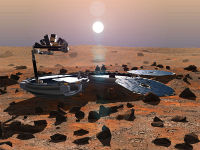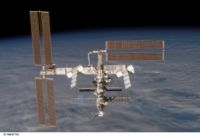Difference between revisions of "Solar panel"
(Cassini mission was to Saturn, not Jupiter.) |
m (interlinks) |
||
| Line 1: | Line 1: | ||
[[Image:Beagle2.jpg|thumb|right|200px|An artists impression of the ill-fated [[Beagle 2]] lander. The prominent '''solar panels''' are deployed.]] | [[Image:Beagle2.jpg|thumb|right|200px|An artists impression of the ill-fated [[Beagle 2]] lander. The prominent '''solar panels''' are deployed.]] | ||
| − | '''Solar Panels''' generate electric [[energy]] out of [[sunlight]]. Usually they are constructed from a semi-conductor such as [[silicon]]. Solar panels are frequently used in space primarily for [[:category:orbiters (Terrestrial)|satellites and space stations in Earth orbit]] and is the prime source of energy for [[Mars]] [[:category:orbiters|satellites]], [[:category:landers|landers]] and [[:category:rovers|rovers]]. Solar panels begin to lose usefulness for deep space and outer solar system missions (i.e. the [[Cassini]] mission to Saturn or the [[Voyager]] program) where [[radioisotope thermoelectric generator]]s are the favoured (if controversial) means to generate electricity. | + | '''Solar Panels''' generate electric [[energy]] out of [[sunlight]]. Usually they are constructed from a semi-conductor such as [[silicon]]. Solar panels are frequently used in space primarily for [[:category:orbiters (Terrestrial)|satellites and space stations in Earth orbit]] and is the prime source of energy for [[Mars]] [[:category:orbiters|satellites]], [[:category:landers|landers]] and [[:category:rovers|rovers]]. Solar panels begin to lose usefulness for deep space and outer solar system missions (i.e. the [[Cassini]] mission to Saturn or the [[Voyager]] program) where [[radioisotope thermoelectric generator]]s are the favoured (if controversial) means to generate [[electricity]]. |
[[Image:Iss.jpg|thumb|left|200px|The [[International Space Station]] in Earth orbit. The huge solar arrays provide the station's electrical power.]] | [[Image:Iss.jpg|thumb|left|200px|The [[International Space Station]] in Earth orbit. The huge solar arrays provide the station's electrical power.]] | ||
| − | On [[Mars]] the sunlight is bright enough to use solar panels. The famous rovers [[Spirit]] and [[Opportunity]] have them. The experiences are terrific: Since July 2003 they are working fine, and the Martian [[wind]]s have kept the surfaces clear of dust. However, the rovers cannot operate at full capacity during the Martian winter when the intensity of the sunlight is reduced, and dust storms have from time to time caused severe reductions in the available power, requiring the rovers to go into a low-power "hibernation" mode. | + | On [[Mars]] the sunlight is bright enough to use solar panels. The famous rovers [[Spirit]] and [[Opportunity]] have them. The experiences are terrific: Since July 2003 they are working fine, and the Martian [[wind]]s have kept the surfaces clear of dust. However, the rovers cannot operate at full capacity during the Martian winter when the intensity of the sunlight is reduced, and [[dust storms]] have from time to time caused severe reductions in the available power, requiring the rovers to go into a low-power "hibernation" mode. |
A major drawback to using solar power is the requirement for some form of [[energy storage]] to keep power available during the Martian night. | A major drawback to using solar power is the requirement for some form of [[energy storage]] to keep power available during the Martian night. | ||
Revision as of 15:40, 12 December 2008

Solar Panels generate electric energy out of sunlight. Usually they are constructed from a semi-conductor such as silicon. Solar panels are frequently used in space primarily for satellites and space stations in Earth orbit and is the prime source of energy for Mars satellites, landers and rovers. Solar panels begin to lose usefulness for deep space and outer solar system missions (i.e. the Cassini mission to Saturn or the Voyager program) where radioisotope thermoelectric generators are the favoured (if controversial) means to generate electricity.

On Mars the sunlight is bright enough to use solar panels. The famous rovers Spirit and Opportunity have them. The experiences are terrific: Since July 2003 they are working fine, and the Martian winds have kept the surfaces clear of dust. However, the rovers cannot operate at full capacity during the Martian winter when the intensity of the sunlight is reduced, and dust storms have from time to time caused severe reductions in the available power, requiring the rovers to go into a low-power "hibernation" mode.
A major drawback to using solar power is the requirement for some form of energy storage to keep power available during the Martian night.






